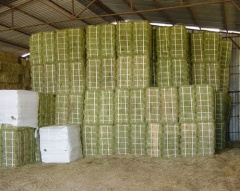Alfalfa (Lucerne)
| Infobox on Alfalfa (Lucerne) | |
|---|---|
| Example of Alfalfa (Lucerne) |  |
| Facts | |
| Origin | Various |
| Stowage factor (in m3/t) | 3,3-4,4 m3/t |
| Humidity / moisture | - |
| Ventilation | See text |
| Risk factors | See text |
Alfalfa (Lucerne)
Description/application
Alfalfa is widely grown throughout the world as forage for cattle, and is most often harvested as hay, but can also be made into silage, grazed, or fed as greenchop. Alfalfa usually has the highest feeding value of all common hay crops. It is used less frequently as pasture. When grown on soils where it is well-adapted, alfalfa is often the highest yielding forage plant, but its primary benefit is the combination of high yield per hectare and high nutritional quality.
When alfalfa is to be used as hay, it is usually cut and baled. Loose haystacks are still used in some areas, but bales are easier for use in transportation, storage and feed. Ideally, the first cutting should be taken at the bud stage, and the subsequent cuttings just as the field is beginning to flower, or one tenth bloom for the reason that carbohydrates are at their highest. When using farm equipment rather than hand-harvesting, a swather cuts the alfalfa and arranges it in windrows. In areas where the alfalfa does not immediately dry out on its own, a machine known as a mower-conditioner is used to cut the hay. The mower-conditioner has a set of rollers or flails that crimp and break the stems as they pass through the mower, making the alfalfa dry faster.
When used as feed for dairy cattle, alfalfa is often made into haylage by a process known as ensiling. Rather than drying it to make dry hay, the alfalfa is chopped finely and fermented in silos, trenches, or bags, anywhere the oxygen supply can be limited to promote fermentation. The anaerobic fermentation of alfalfa allows it to retain high nutrient levels similar to those of fresh forage, and is also more palatable to dairy cattle than dry hay. In many cases, alfalfa silage is inoculated with different strains of microorganisms to improve the fermentation quality and aerobic stability of the silage.
Shipment/storage
Dry grass fodder shipped in bales more or less compressed. Also shipped in the form of meal and pellets.
Must be kept dry as absorption of moisture generates heat and leads to mildew. Frequently cut and bundled when green and moist which will also cause heating and deterioration. Should be protected from strong odours. Emits a green dust.
Loose, wet or damp bales should not be received on board under any circumstances; all broken bales should be rejected. It is pressed into bales of varying densities. If stowing large quantities, air shafts should be introduced to ensure air circulating through the stowage, where no mechanical ventilation is available, as proper ventilation is essential to avoid heating and spontaneous combustion.
Every protection against an outbreak of fire should be taken.
Risk factors
- Moisture (mould) damage
- Odour
- Heating damage
Reference is made to the relevant IMO publications of hazardous cargo.











